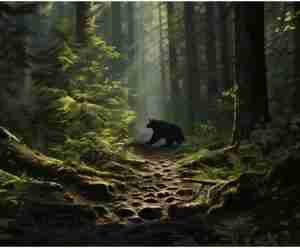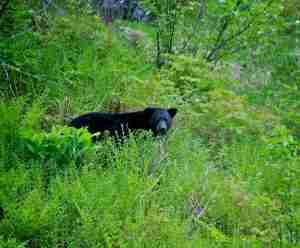You might think that tracking black bears is best left to the bears themselves. But no, you can surely do it— safely and effectively, of course!
Many hunters and wildlife photographers have probably tried tracking bears, and one of their main concerns is what’s in there and how to do it properly.
In this guide, we’ll explain why you might want to engage in this unusual pastime, the various methods used to track black bears, and some tips to make your tracking endeavors more effective.
Table of Contents
Why Track Black Bears?

Just like a detective unravels a mystery by following subtle clues, tracking black bears isn’t just about the thrill of the chase; it’s about piecing together the puzzle of their existence.
Tracking black bears takes us deeper into understanding their behavior, interactions with the environment, and, ultimately, their role in the grand tapestry of nature.
As responsible hunters, it’s important to keep a check on bear populations and only hunt within the limitations and guidelines set without endangering the species.
Methods of Tracking Black Bears
As an enthusiast, you may wonder about the various methods you can employ to track black bears. And we’re here to help you understand some popular methods to do it.
Each method offers unique advantages and challenges, providing a comprehensive approach to understanding and monitoring black bear behaviors and movements.
Visual Tracking
You’ll find visual tracking fascinating, like reading a story written by the bear in the wilderness.
It’s all about interpreting:
- Bear footprints: like the bear’s own autograph in the dirt
- Scat: gross, but informative! It’s a bear’s way of saying, “I was here, and I had berries for lunch.”
- Claw marks: a bear’s idea of tree art, showing just how tall and strong they are.
Scouting and Stalking
Scouting and stalking bears in their natural habitat aren’t for the faint-hearted. It’s an adrenaline-filled adventure that requires patience, stealth, and a deep understanding of these majestic creatures.
You must play detective, deciphering bear signs like a CSI in the wilderness. Remember, stepping on a twig can mean game over. These guys have ears like a bat and a nose better than a bloodhound!
Using GPS Device
With a GPS device handy, you’re not just barking up the wrong tree; you’re tapping into a high-tech way of studying bear movements and patterns.
We all know that the bear’s behavior can be unpredictable. A GPS allows you to track the bear safely without disturbing it or putting yourself in unnecessary danger.
Also, using GPS devices offer extreme accuracy. They help you identify your exact location and tell you how far you are from the bear, which can be very helpful in formulating your hunting strategy.
Using Hunting Dogs
Using hound dogs to assist in tracking a bear is a traditional hunting method with several advantages, specifically due to a dog’s enhanced sense of smell and tireless perseverance.
Hounds have an exceptional ability to pick up and follow a scent trail. They can trace a bear’s path despite minimal physical signs.
Also, hounds are known for their tenacity and stamina. They can tirelessly track the bear for hours and over long distances, often faster and more determinedly than a human would manage to do.
Tips for Effective Bear Tracking

Develop Tracking Skills
You’ll find that developing your tracking skills is no walk in the park, but remember, practice makes perfect. Here’s a handy list of bear-essentials:
- Spotting tracks: Look for the classic bear paw print.
- Identifying scat: If it’s full of berries, it’s bear-y likely.
- Examining tree scratches: Bears love a good back scratch.
- Finding dens: Cozy caves or hollow trees.
- Observing feeding sites: Empty picnic baskets are a dead giveaway.
Remember, the bear necessities come to you with practice!
Patience and Persistence
In the world of bear observation, your persistence will be rewarded with the sight of a furry giant nosing around a berry bush or lumbering along a forest trail.
You can’t rush a black bear. They move at their own pace, and you’ve gotta respect that.
So, grab a thermos of coffee, pack your patience, and prepare for a brilliant day of tracking.
Safety Considerations
Before you venture into the wilderness, it’s absolutely essential to remember the importance of safety when it comes to potentially coming face-to-face with these magnificent creatures.
Here are some bear essentials:
- Keep your bearings by following local guidelines.
- Never attempt a bear hug; maintain a safe distance.
- If a confrontation arises, don’t play dead, just bear it and retreat slowly.
Frequently Asked Questions
What is the average lifespan of a black bear?
You’re wondering about a black bear’s lifespan, aren’t you? Well, they’re quite the aging champions! These furry fellows can live up to 20 years in the wild on average.
How do black bears interact with their environment and other species?
You’d think black bears are party animals! They interact with their environment by foraging, climbing trees, swimming, and hunting.
They’re quite the social butterflies with other species, often showing mutual respect and avoidance.
What are some preventive measures to avoid attracting black bears in residential areas?
Secure trash cans, don’t feed pets outdoors, and remove bird feeders. Clean grills after use and store them inside. Remember, your yard isn’t a black bear’s all-you-can-eat buffet!
What do black bears typically eat and how does this change with the seasons?
Black bears aren’t picky eaters. In spring, they munch on grasses and berries. Come summer, it’s insects and fish. Autumn calls for nuts and fruits. In winter, they’re living the dream – sleeping, not eating!
Can black bears be dangerous to humans, and if so, under what circumstances?
Sure, black bears can be a real hoot when they’re dangerous. It’s when they’re protecting cubs, feel threatened, or if you’re between them and their favorite blueberry bush.
Conclusion
In conclusion, tracking black bears is crucial for their conservation and the various methods to do so. Surprisingly, you might stumble upon a bear track while on a casual hike.
Don’t panic, it’s all part of the adventure!
- Gun Ranges For Beginners - January 25, 2024
- How To Build Indoor Gun Range: Your Ultimate Blueprint - January 25, 2024
- How To Find the Cheap Shooting Range Near Me? - January 25, 2024
